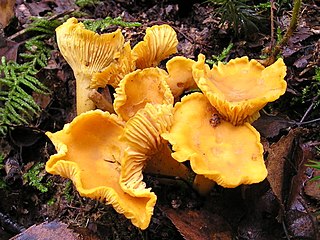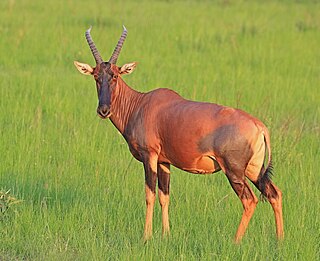
The Cantharellaceae are a family of fungi in the order Cantharellales. The family contains the chanterelles and related species, a group of fungi that superficially resemble agarics but have smooth, wrinkled, or gill-like hymenophores. Species in the family are ectomycorrhizal, forming a mutually beneficial relationship with the roots of trees and other plants. Many of the Cantharellaceae, including the chanterelle, the Pacific golden chanterelle, the horn of plenty, and the trumpet chanterelle, are not only edible, but are collected and marketed internationally on a commercial scale.

The Cantharellales are an order of fungi in the class Agaricomycetes. The order includes not only the chanterelles (Cantharellaceae), but also some of the tooth fungi (Hydnaceae), clavarioid fungi, and corticioid fungi (Botryobasidiaceae). Species within the order are variously ectomycorrhizal, saprotrophic, associated with orchids, or facultative plant pathogens. Those of economic importance include edible and commercially collected Cantharellus, Craterellus, and Hydnum species as well as crop pathogens in the genera Ceratobasidium and Thanatephorus (Rhizoctonia).

Cantharellus is a genus of popular edible mushrooms, commonly known as chanterelles, a name which can also refer to the type species, Cantharellus cibarius. They are mycorrhizal fungi, meaning they form symbiotic associations with plants, making them very difficult to cultivate. Caution must be used when identifying chanterelles for consumption due to lookalikes, such as the jack-o'-lantern mushroom, which can make a person very ill. Despite this, chanterelles are one of the most recognized and harvested groups of edible mushrooms.

Old World monkey is the common English name for a family of primates known taxonomically as the Cercopithecidae. Twenty-four genera and 138 species are recognized, making it the largest primate family. Old World monkey genera include baboons, red colobus and macaques. Common names for other Old World monkeys include the talapoin, guenon, colobus, douc, vervet, gelada, mangabey, langur, mandrill, surili (Presbytis), patas, and proboscis monkey. Phylogenetically, they are more closely related to apes than to New World monkeys. They diverged from a common ancestor of New World monkeys around 45 to 55 million years ago.

Struthio is a genus of birds in the order Struthioniformes, whose members are the ostriches. It is part of the infra-class Palaeognathae, a diverse group of flightless birds also known as ratites that includes the emus, rheas, and kiwis. There are two living species of ostrich: the common ostrich and the Somali ostrich. They are large flightless birds of Africa who lay the largest eggs of any living land animal. With the ability to run at 70 km/h (43.5 mph), they are the fastest birds on land. They are farmed worldwide, particularly for their feathers as they are used as decoration and feather dusters. Their skin is also used for leather products. Ostriches are notable for being the heaviest living birds.

Aonyx is a genus of otters, containing three species, the African clawless otter, the Congo clawless otter, and the Asian small-clawed otter. The word aonyx means "clawless", derived from the prefix a- ("without") and onyx ("claw/hoof").

Taurotragus is a genus of large antelopes of the African savanna, commonly known as elands. It contains two species: the common eland T. oryx and the giant eland T. derbianus.

Damaliscus, commonly known as tsessebes, is a genus of antelope in the family Bovidae, subfamily Alcelaphinae, found in Africa.

Kinixys, commonly known as the hinge-back tortoise, is a genus of turtles in the family Testudinidae. The genus was erected by Thomas Bell in 1827. The species in the genus Kinixys are native to mainland Africa and commonly known as hinged tortoises.

A gazelle is any of many antelope species in the genus Gazella. This article also deals with the seven species included in two further genera, Eudorcas and Nanger, which were formerly considered subgenera of Gazella. A third former subgenus, Procapra, includes three living species of Asian gazelles.

Cantharellus lateritius, commonly known as the smooth chanterelle, is a species of edible fungus in the mushroom family Cantharellaceae. An ectomycorrhizal species, it is found in Asia, Africa, and North America. The species has a complex taxonomic history, and has undergone several name changes since its first description by American mycologist Lewis David de Schweinitz in 1822. The fruit bodies of the fungus are brightly colored yellow to orange, and usually highly conspicuous against the soil in which they are found. At maturity, the mushroom resembles a filled funnel with the spore-bearing surface along the sloping outer sides. The texture of the fertile undersurface (hymenium) of the caps is a distinguishing characteristic of the species: unlike the well-known golden chanterelle, the hymenium of C. lateritius is much smoother. Chemical analysis has revealed the presence of several carotenoid compounds in the fruit bodies.
Goossensia is a fungal genus in the family Cantharellaceae. It is a monotypic genus, and contains one species, Goossensia cibarioides, found in the Congo. The genus was circumscribed by the Belgian mycologist Paul Heinemann in 1958.
Parastereopsis is a genus of fungi in the family Cantharellaceae. It is a monotypic genus, and contains one species, Parastereopsis borneensis, described as new to science by British mycologist E.J.H. Corner in 1976.

Pseudocraterellus is a genus of fungi in the family Cantharellaceae.
Afrocantharellus fistulosus is a species of fungus in the family Cantharellaceae. First described in 2008 as a species of Cantharellus, it was transferred to the new genus Afrocantharellus in 2012.

Afrocantharellus platyphyllus is a species of fungus in the family Cantharellaceae. First described in 1966 as a species of Cantharellus, it was transferred to the new genus Afrocantharellus in 2012.
Afrocantharellus splendens is a species of fungus in the family Cantharellaceae. First described in 1994 as a species of Cantharellus, it was transferred to the new genus Afrocantharellus in 2012.
Afrocantharellus symoensii is a species of fungus in the family Cantharellaceae. First described by mycologist Paul Heinemann in 1966 as a species of Cantharellus, it was transferred to the new genus Afrocantharellus in 2012.
Pseudocraterellus pseudoclavatus is a species of fungus in the family Cantharellaceae. Smith described it in 1947 as Cantharellus pseudoclavatus, from a collection of a mushroom from the Siskiyou Fork of the Smith River in northern California. He reported it occurred in Washtenaw and Oakland counties in Michigan in oak hickory forest but added that he had mistaken it for G. clavatus as the two were very similar in appearance and hence it could be more widespread. He placed it in the subgenus Gomphus.
Burgoa is a genus of fungi belonging to the family Cantharellaceae.













